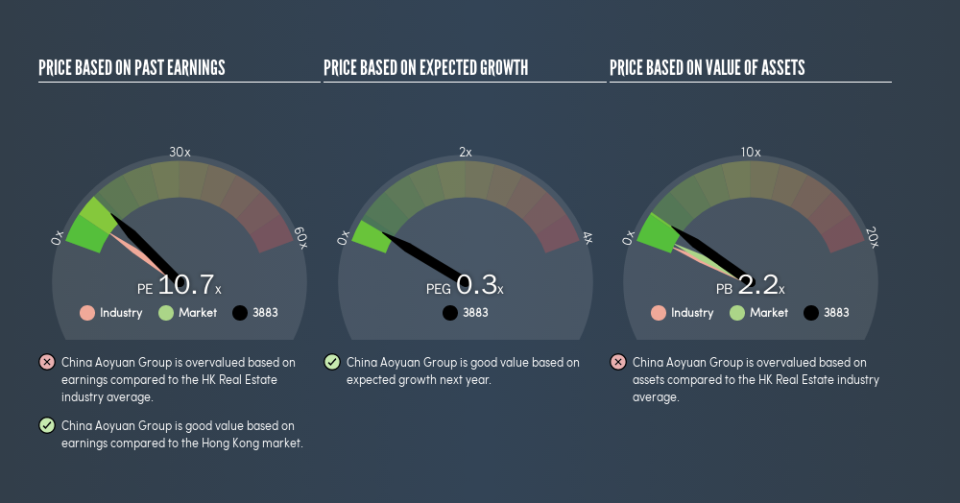Despite Its High P/E Ratio, Is China Aoyuan Group Limited (HKG:3883) Still Undervalued?

Want to participate in a short research study? Help shape the future of investing tools and you could win a $250 gift card!
This article is written for those who want to get better at using price to earnings ratios (P/E ratios). We'll show how you can use China Aoyuan Group Limited's (HKG:3883) P/E ratio to inform your assessment of the investment opportunity. Based on the last twelve months, China Aoyuan Group's P/E ratio is 10.74. That corresponds to an earnings yield of approximately 9.3%.
View our latest analysis for China Aoyuan Group
How Do You Calculate China Aoyuan Group's P/E Ratio?
The formula for P/E is:
Price to Earnings Ratio = Share Price (in reporting currency) ÷ Earnings per Share (EPS)
Or for China Aoyuan Group:
P/E of 10.74 = CN¥9.65 (Note: this is the share price in the reporting currency, namely, CNY ) ÷ CN¥0.90 (Based on the year to December 2018.)
Is A High P/E Ratio Good?
A higher P/E ratio means that buyers have to pay a higher price for each HK$1 the company has earned over the last year. All else being equal, it's better to pay a low price -- but as Warren Buffett said, 'It's far better to buy a wonderful company at a fair price than a fair company at a wonderful price.'
How Growth Rates Impact P/E Ratios
Probably the most important factor in determining what P/E a company trades on is the earnings growth. That's because companies that grow earnings per share quickly will rapidly increase the 'E' in the equation. And in that case, the P/E ratio itself will drop rather quickly. Then, a lower P/E should attract more buyers, pushing the share price up.
China Aoyuan Group increased earnings per share by a whopping 47% last year. And its annual EPS growth rate over 5 years is 27%. So we'd generally expect it to have a relatively high P/E ratio.
Does China Aoyuan Group Have A Relatively High Or Low P/E For Its Industry?
One good way to get a quick read on what market participants expect of a company is to look at its P/E ratio. As you can see below, China Aoyuan Group has a higher P/E than the average company (6.5) in the real estate industry.
China Aoyuan Group's P/E tells us that market participants think the company will perform better than its industry peers, going forward. Shareholders are clearly optimistic, but the future is always uncertain. So investors should delve deeper. I like to check if company insiders have been buying or selling.
Don't Forget: The P/E Does Not Account For Debt or Bank Deposits
The 'Price' in P/E reflects the market capitalization of the company. So it won't reflect the advantage of cash, or disadvantage of debt. Theoretically, a business can improve its earnings (and produce a lower P/E in the future) by investing in growth. That means taking on debt (or spending its cash).
Spending on growth might be good or bad a few years later, but the point is that the P/E ratio does not account for the option (or lack thereof).
How Does China Aoyuan Group's Debt Impact Its P/E Ratio?
Net debt totals 88% of China Aoyuan Group's market cap. If you want to compare its P/E ratio to other companies, you should absolutely keep in mind it has significant borrowings.
The Bottom Line On China Aoyuan Group's P/E Ratio
China Aoyuan Group has a P/E of 10.7. That's around the same as the average in the HK market, which is 11. The significant levels of debt do detract somewhat from the strong earnings growth. However, the P/E ratio implies that most doubt the strong growth will continue.
Investors should be looking to buy stocks that the market is wrong about. As value investor Benjamin Graham famously said, 'In the short run, the market is a voting machine but in the long run, it is a weighing machine.' So this free visual report on analyst forecasts could hold the key to an excellent investment decision.
Of course, you might find a fantastic investment by looking at a few good candidates. So take a peek at this free list of companies with modest (or no) debt, trading on a P/E below 20.
We aim to bring you long-term focused research analysis driven by fundamental data. Note that our analysis may not factor in the latest price-sensitive company announcements or qualitative material.
If you spot an error that warrants correction, please contact the editor at editorial-team@simplywallst.com. This article by Simply Wall St is general in nature. It does not constitute a recommendation to buy or sell any stock, and does not take account of your objectives, or your financial situation. Simply Wall St has no position in the stocks mentioned. Thank you for reading.

